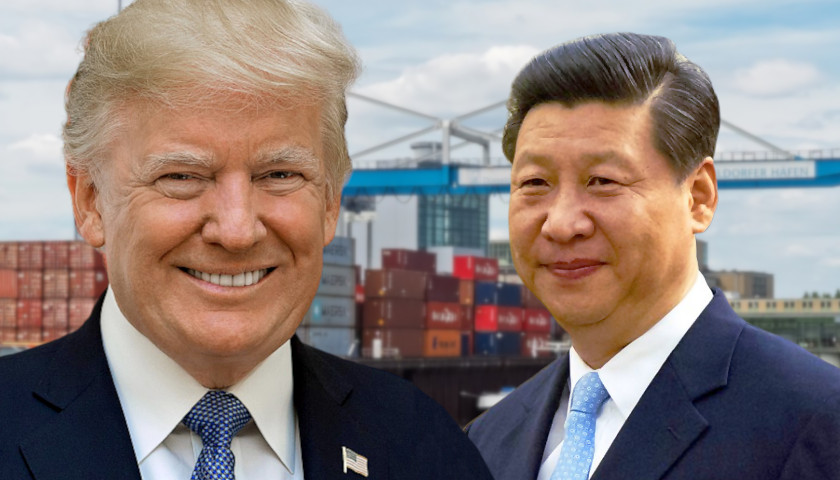by Curtis Ellis
Chinese Vice Premier and Communist Party Politburo member Liu He is in Washington this week to sign a trade agreement with the Trump Administration.
In making the so-called phase-one trade deal, China agreed to increase purchases of U.S. agriculture, energy services, and manufactured goods by $200 billion; open its markets to U.S. banks, credit card companies, and other financial services; and end its long-standing practice of forcing foreign companies to transfer their technology to Chinese “partners” as a condition for doing business in China.
But the most important thing about the deal is the deal itself.
Before President Trump came on the scene, most people thought—to the extent they thought about it at all—we already had a trade deal with China. And many, too many, thought it was just fine.
Trade with China was considered a given, the furniture. President Trump rearranged the furniture.
The phase-one deal exemplifies how the president has remade our relations with China and reset the debate on trade and the economy.
Previous administrations as well as the policymaking and media elites accepted the prior terms of our dealings with Communist China. It was assumed our economies would be forever intertwined in a symbiotic entity dubbed “Chimerica.”
But “symbiosis” suggests mutual advantage, and our economic relationship with China has been anything but advantageous to us.
The United States lost 2.7 million jobs as factories closed and moved to red China. Life expectancy dropped in America as suicide, overdose, and alcoholism rates surged among our beleaguered citizenry.
The gee-whiz analysts of our fifth estate would dutifully parrot China’s state-controlled media claim that the Chinese Communist Party “lifted 700 million people out of poverty.”
In fact, it was Western capital that lifted their fortunes even as the fortunes of Americans sunk.
Donald J. Trump was the first figure on the national political stage to acknowledge our trade relationships with China and other nations were deeply dysfunctional. He vowed to do something about them rather than simply mouth bumper sticker platitudes about “leveling the playing field,” “better education and retraining,” and “American workers being able to outcompete the rest of the world.” His candor was a breath of fresh air to voters and they vaulted him to the White House.
The new deal with China heralds a new recognition of reality, a dramatic change from the status quo ante.
Previous presidents believed they could trust the Chinese Communist Party. President Trump insisted on verifiable enforcement and explicitly retained the right to impose tariffs unilaterally if we determined Beijing was not living up to the agreement.
While previous presidents pretended China was our friend or would be if we just kept giving them our jobs, technology, and industries, President Trump recognized the Chinese Communist Party seeks to take over the world.
While President Obama had a photo op in the Rose Garden with Xi Xinping, who pledged to end cyberespionage, President Trump has the FBI roll up the Chinese spies crawling all over our military bases, labs, and universities. He’s cracked down on Huawei, the espionage arm of the Chinese People’s Liberation Army disguised as a tech firm, and cut off access to crucial American technologies that previous administrations were more than happy to sell to Beijing.
Instead of encouraging American businesses to expand their operations in China where rule of law is a fantasy, President Trump orders businesses to diversify their supply chains away from China, and says Beijing needs to straighten up and fly right.
While others remain focused solely on removing tariffs, President Trump understands the bigger picture: other nations are unsuitable platforms for American jobs.
He renegotiated the South Korea trade deal to get better terms for American producers. USMCA, the renegotiation of NAFTA promised on the campaign trail, returns jobs to American shores by updating the rules of origin to require more local content for parts and higher wages for the labor used to manufacture vehicles sold in the United States.
In the phase-one deal with China we see a microcosm of how President Trump has remade our foreign trade policy.
It may well be that Trump was the last person in our lifetime capable of making this course correction.
College and university students now major in “supply chain management,” a fancy way of saying outsourcing to cheap foreign labor to avoid American environmental, safety, and tax laws. President Trump remembers we used to make things in America, and he understands we must do so again to be prosperous.
Major corporations and media networks now tout the concept of a “global citizen,” our elites imagine “there’s no countries” and pledge allegiance to a theoretical concept, “the global economy.” They see nationalism as a disease that must be extirpated. President Trump proudly declares himself a nationalist. His allegiance is to America, and he is happy to say he is president of the United States, not president of the world.
For more than the last half century, American foreign policy was driven by the concept of eroding national sovereignty, making the world safe for multinational companies to operate without restrictions by sovereign nations. President Trump’s guiding star is to make America, not “the global economy” or stateless global corporations, great again.
Economic nationalism is a cornerstone of Trump’s America First agenda. Rather than perpetuating the low-wage, low productivity model built on a never-ending supply of cheap foreign labor, America Firsters seek to return to the high-wage, high-productivity model that produced the broad-based prosperity members of Trump’s generation remember.
This model, the historical norm in our country, had a name: the American system.
– – –
Curtis Ellis is policy director with America First Policies. He was also a senior policy advisor with the Donald J. Trump presidential campaign in 2016.





